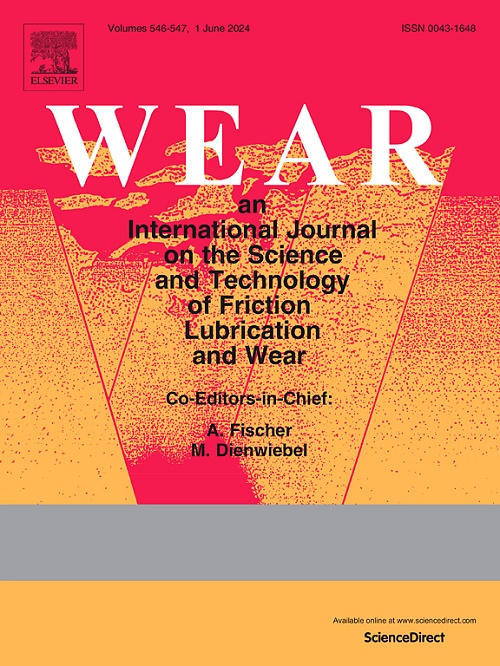The influence of repeated multiple braking cycles on the evolution of wear degradation of friction blocks
IF 5.3
1区 工程技术
Q1 ENGINEERING, MECHANICAL
引用次数: 0
Abstract
This article studies the contact pressure and wear distribution of friction blocks during repeated braking processes, as well as the influence of braking duration on friction block wear degradation. Research has found that as the braking duration increases under repeated braking conditions, the wear of the friction block intensifies, and the size of interface damage increases but decreases in quantity. The difference between service conditions and running-in conditions may cause the friction blocks to re-enter the running-in state. During the first braking of repeated braking, the high contact stress area and main wear area of the friction block gradually transfer from the cutting-in end to the center area of the friction block, and finally, under the combined action of thermal expansion, wear behavior, and relative motion, the surface wear of the friction block gradually reaches a dynamic equilibrium state. In the initial stage of the subsequent braking process, the stress concentration phenomenon in the outer ring edge area of the friction block is extremely significant. Under repeated braking conditions, if the duration of each braking is sufficient to bring the friction block to a stable state of dynamic equilibrium, the friction block will exhibit similar wear behavior in subsequent braking conditions.
重复多次制动循环对摩擦块磨损退化演化的影响
本文研究了重复制动过程中摩擦块的接触压力和磨损分布,以及制动时间对摩擦块磨损退化的影响。研究发现,在重复制动工况下,随着制动时间的增加,摩擦块磨损加剧,界面损伤尺寸增大而数量减小。使用条件与磨合条件的差异可能导致摩擦块重新进入磨合状态。在重复制动的第一次制动过程中,摩擦块的高接触应力区和主要磨损区逐渐从切入端转移到摩擦块的中心区域,最后在热膨胀、磨损行为和相对运动的共同作用下,摩擦块的表面磨损逐渐达到动态平衡状态。在后续制动过程的初始阶段,摩擦块外圈边缘区域的应力集中现象极为显著。在重复制动条件下,如果每次制动的持续时间足以使摩擦块达到动态平衡的稳定状态,则摩擦块在随后的制动条件下会表现出类似的磨损行为。
本文章由计算机程序翻译,如有差异,请以英文原文为准。
求助全文
约1分钟内获得全文
求助全文
来源期刊

Wear
工程技术-材料科学:综合
CiteScore
8.80
自引率
8.00%
发文量
280
审稿时长
47 days
期刊介绍:
Wear journal is dedicated to the advancement of basic and applied knowledge concerning the nature of wear of materials. Broadly, topics of interest range from development of fundamental understanding of the mechanisms of wear to innovative solutions to practical engineering problems. Authors of experimental studies are expected to comment on the repeatability of the data, and whenever possible, conduct multiple measurements under similar testing conditions. Further, Wear embraces the highest standards of professional ethics, and the detection of matching content, either in written or graphical form, from other publications by the current authors or by others, may result in rejection.
 求助内容:
求助内容: 应助结果提醒方式:
应助结果提醒方式:


